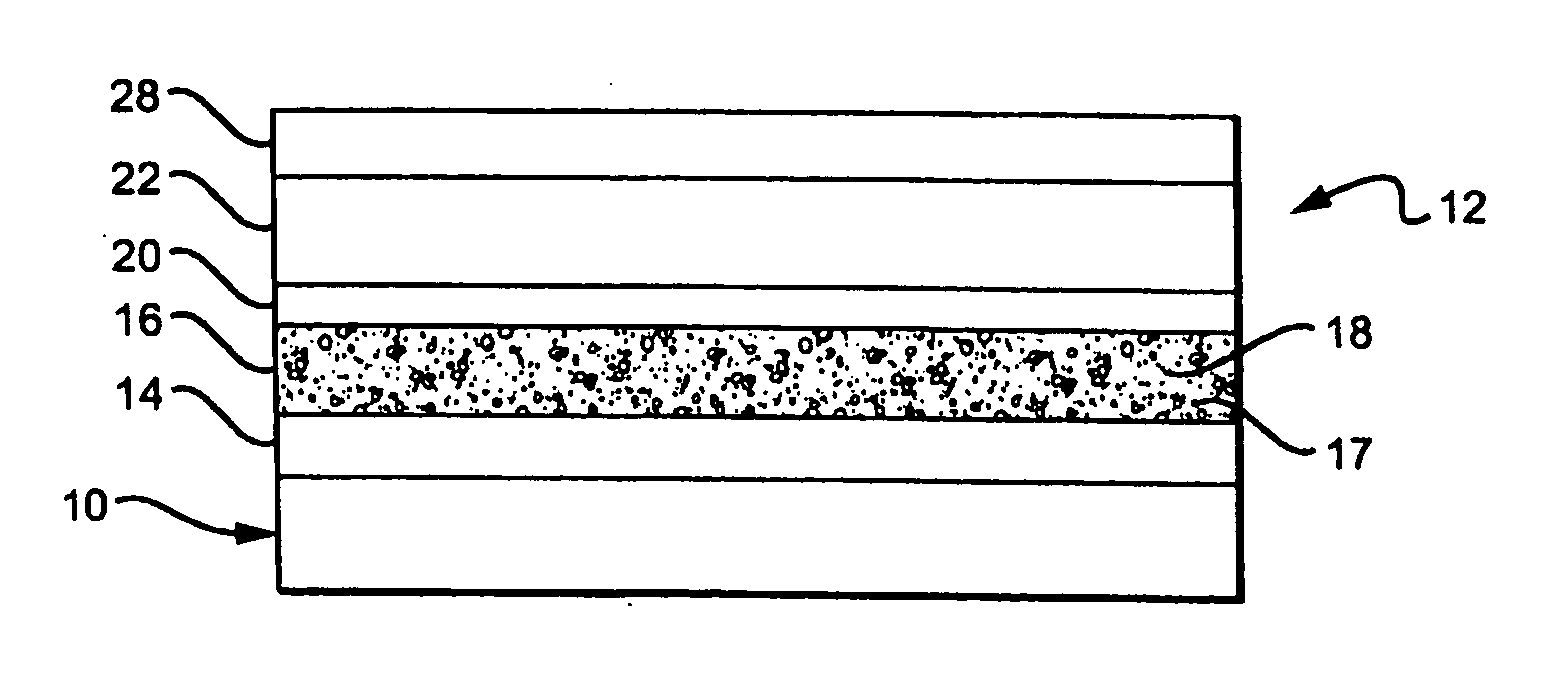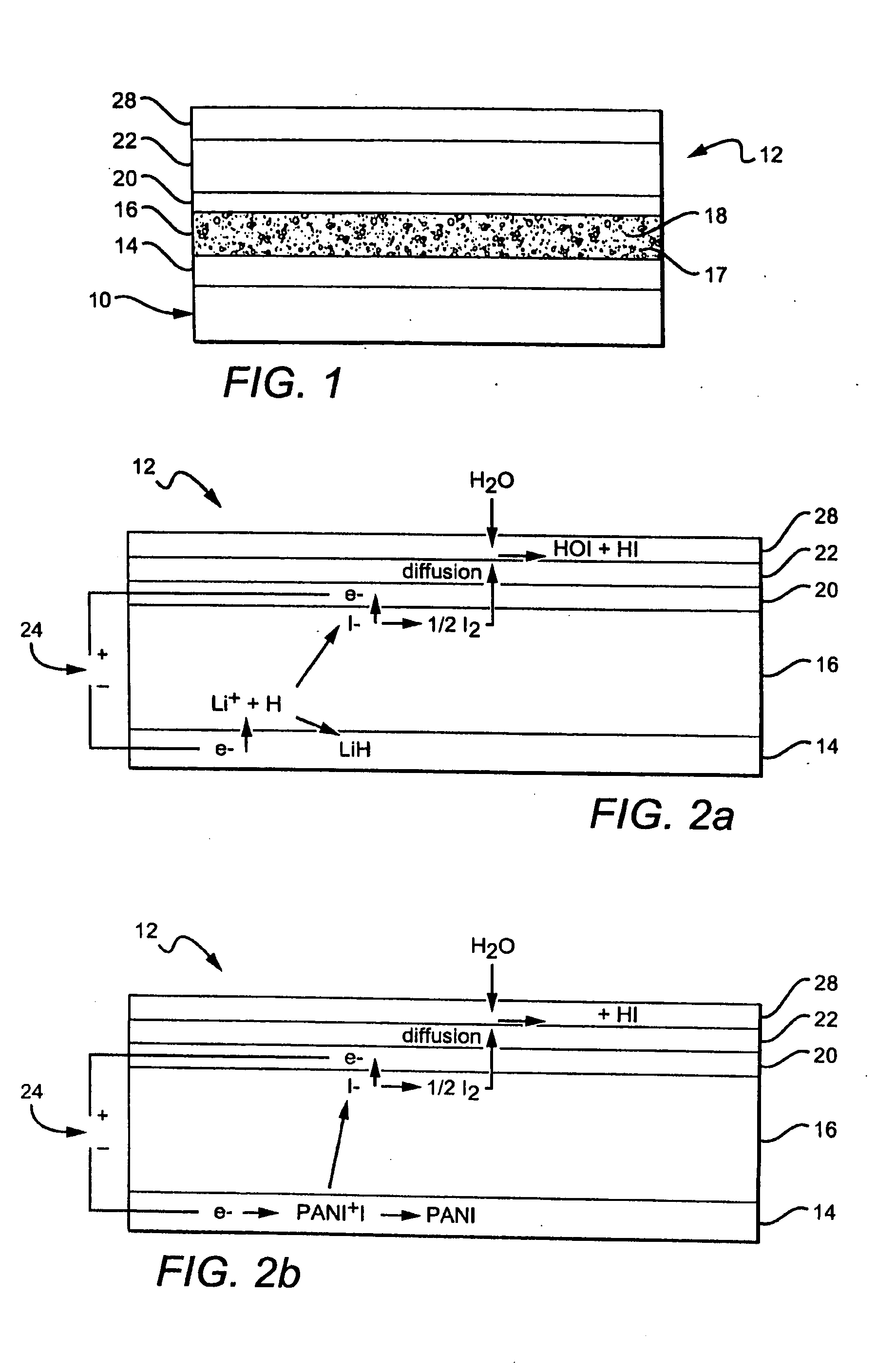Multilayer self-decontaminating coatings
- Summary
- Abstract
- Description
- Claims
- Application Information
AI Technical Summary
Benefits of technology
Problems solved by technology
Method used
Image
Examples
example 1
[0071]An experimental cell constructed as in FIG. 2b with PANI iodide cathode, an electrolyte containing EC, PC, PAN, TPAI (34:50:7.77:7.77 by weight), a Teflon fabric separator and a platinized carbon anode was polarized with a positive voltage applied to the anode vs the cathode for five minute intervals.
[0072]Iodine flowing from the coating was detected by exposure to a disk of Watman #44 filter paper which was previously soaked in 0.5 M KI and then dried. A 6 mm diameter disk cut from the paper was placed over the multilayer coating to react with the evolving elemental iodine. The reaction immobilized the evolved I2 vapor as brown KI3 product within the paper through the reaction:
[0073]Subsequently, the exposed disk containing immobilized elemental iodine developed an intense blue color when placed in a test tube to which was added 2 mL of 1% starch solution (Aldrich 319554). Iodide (I), in contrast, develops no color. The blue color developed by the ...
example 2
[0074]A first example of a layered electrochemical cell uses a cathode 14 containing a combination of Ketjen black (an oil furnace carbon black) and PANT iodide, preferably 21%w Ketjen black and 79%w PANI iodide, and an electrolyte layer 16 comprising a polyacrylonitrile (PAN) gel 17, from about 7 to about 8% tetrapropyl ammonium iodide (TPAI) 18, from about 33 to about 34%w ethylene carbonate (EC), from about 48 to about 50%w of propylene carbonate (PC) and from about 8 to about 12%w of PAN.
[0075]The anode 20 contained platinized carbon with a PVA (Polyvinyl alcohol) binder, platinized woven carbon fabric, or a platinized carbon fiber tissue (obtained from Tech Fiber Products), preferably about 1%w Pt in carbon. The surface covering / membrane 22, 28 was a hydrophobic porous membrane or microporous filter paper, typically coated with a polyurethane or a fluorocarbon formed of Teflon®, Fluorothane™ or Sartech H. As an alternative, a Teflon separator may also be placed between the elec...
example 3
[0076]A second example of the layered electrochemical cell 12 contains:[0077]1) a cathode 14 containing a coating formed from a paste of ground 2,5 dimercapto-1,3,4 thiadiazole, a conducting polymer such as set forth in U.S. Pat. No. 5,665,492, dispersed in a carrier liquid, forming a flowable liquid that is painted on the device, structure or substrate. Alternatively, polyanaline iodide (PANI iodide) can be electrodeposited or otherwise deposited on the surface. As a third alternative, Prussian Blue can be electrodeposited on the substrate or dispersed in a carrier liquid and painted on the surface.[0078]2) The electrolyte layer 16 contains a hydrophobic ionic layer which includes a halide containing compound 18, for example KI or other solid or gel electrolyte containing KI.[0079]3) The anode 20 may be a porous, solid conductor which can be formed from a slurry or dispersion of carbon black, platinized carbon black or Pd metallized TiO2. The anode 20 may also include a photosensit...
PUM
| Property | Measurement | Unit |
|---|---|---|
| Flow rate | aaaaa | aaaaa |
| Flexibility | aaaaa | aaaaa |
Abstract
Description
Claims
Application Information
 Login to View More
Login to View More - R&D
- Intellectual Property
- Life Sciences
- Materials
- Tech Scout
- Unparalleled Data Quality
- Higher Quality Content
- 60% Fewer Hallucinations
Browse by: Latest US Patents, China's latest patents, Technical Efficacy Thesaurus, Application Domain, Technology Topic, Popular Technical Reports.
© 2025 PatSnap. All rights reserved.Legal|Privacy policy|Modern Slavery Act Transparency Statement|Sitemap|About US| Contact US: help@patsnap.com



